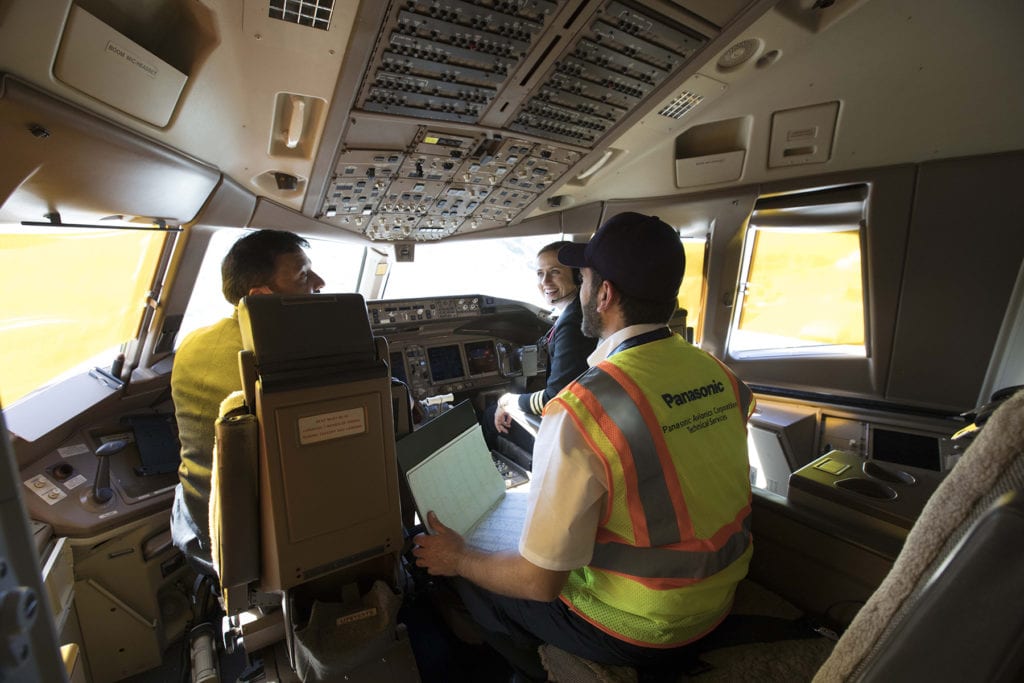
Panasonic Avionics provides separate SSIDs and wireless access points for pilots versus passengers to airlines using its satellite-based in-flight connectivity service. Photo: Panasonic Avionics
Panasonic Avionics has installed its third generation modem on 1,100 aircraft and is preparing to support a promised generational leap in in-flight connectivity speeds for airlines flying in the Asia-Pacific region once the next generation Extreme Throughput Satellite (XTS) service becomes available there next year.
Avionics International spoke to executives and subject matter experts from Panasonic Avionics during the recent 2019 Airline Passenger Experience EXPO to understand what new airliner applications will become available with the combination of the next XTS service, its third generation modem and a new data analytics platform it has developed to aggregate passenger data and give airlines automated insights about passenger IFE consumption trends.
APT Mobile Satcom will operate APSTAR 6D — the satellite behind XTS that will become the first Ku-band high throughput satellite providing coverage over mainland China. Co-designed by Panasonic Avionics, the anchor client to APT Mobile Satcom, the new XTS service will provide 30 Gbps of dedicated high throughput capacity over mainland China.
“Between our third generation modem, and that XTS satellite coming available in early 2020, we’re going to greatly increase our capabilities in the Asia Pacific region,” Paul Kent, director of connectivity products, digital solutions and services for Panasonic Avionics told Avionics.
According to Kent, 250 Mbps is the “theoretical maximum” speed that their modem — developed in partnership with Newtec — can deliver to the aircraft from the satellite. That speed is then divided amongst uses cases between passengers and flight crews. But Panasonic will not be offering the maximum speed as a baseline service to every airline.
Instead, the level of service available will depend on the type of service and business model the airline is trying to support. Kent said Panasonic has seen demand from airlines for a variety of different uses of in-flight connectivity, such as text messaging, but the most bandwidth-intensive applications include those airlines who want to give passengers access to in-flight internet free of charge and streaming video.

Panasonic’s “Next” IFE system has a new ecosystem of in-flight entertainment solutions and applications available. Photo: Panasonic Avionics
Today, 21 Asian carriers, representing over 800 aircraft, have already selected Panasonic for connectivity service, including many of the region’s leading airlines. These include Air China, All Nippon Airways, Cathay Pacific Airways, China Airlines, China Eastern, China Southern, EVA Air, Garuda Indonesia, Hainan Airlines, Hong Kong Airlines, Japan Airlines, Singapore Airlines, Thai Airways and Xiamen Airlines.
Panasonic also wants to enable better access to weather updates, airport conditions and other flight environment information for pilots.
“Operational data is absolutely a large component of what we do, we provision separate SSIDs, for our cabin crews and our flight deck crews that are also separate, we have some provisions where we establish a separate wireless access point for the flight deck, and they will have their own ability to connect and their own apps and their own configurations potentially for separate things they may need to do,” Kent said.
Looking ahead, a future-facing connected aircraft technology roadmap goal for Panasonic is the support of more onboard sensors.
“We have the ability to support cameras, store video footage and send it once the flight has landed or we can capture and send real time footage. There are other sensors on the roadmap, when you talk about the Internet of Things (IoT) and have a truly connected cabin experience onboard and being able to take that aircraft ‘intranet’ and take it to an ‘Internet’ experience where you can take real time measurements for specific data that’s gathered and offloaded, that’s a major focus right now. In terms of IoT sensors in seats, galleys, and lavatories, there’s a number of new smart sensors being introduced and we want to support those from a connected cabin perspective,” Kent said.
Beyond the use of connectivity itself, Gaston Sandoval, vice president of product line management for Panasonic Avionics, says the company is scaling up its use of cloud storage, caching and edge computing to provide airlines with improved analytics about how passengers are engaging with IFE content. Sandoval said currently 65 percent of in-service aircraft use Panasonic IFE.
 | Want to hear more on aircraft connectivity applications? Check out the Global Connected Aircraft Podcast, where Avionics editor-in-chief Woodrow Bellamy III interviews airlines and industry influencers on how they’re applying connectivity solutions. |
Today, Panasonic delivers raw data about passenger engagement with those systems to airlines. However, the launch of Insights at the Aircraft Interiors event in Hamburg earlier this year introduced their new cloud-based data analytics platform to provide an embedded capability for harvesting onboard and third-party data to create a two-way loop between airlines and passengers. Airlines can use the data and analysis derived from Insights to determine what type of content passengers want on specific routes and what type of price points will get more passengers to purchase in-flight internet access, according to Sandoval.
“We’re trying to remove that pain point from requiring airlines to comb through mountains of data, and instead use this new embedded analytics engine to run prescriptive, predictive analytics and descriptive analytics for recommendations on the best Wi-Fi price points. We have many airlines today asking us to help them understand who is watching which movies on various route structures. So we’re starting there and adding more domains to include live television, shopping an more. Insights is going to rapidly evolve over time,” Sandoval said.